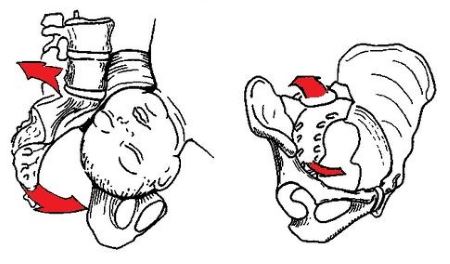Why coccyx pain in men
Coccygodynia, or true secondary, often affects women, that does not prevent a certain percentage of men complain of pain in the coccyx area. Coccygeal pain and in men, and in women may be associated with pathology of the coccyx, and pathology of other organs and systems. So, why a sore tailbone from men?

Main causes of pain
In the list of the most common causes of pain in the sacrococcygeal region in males include:
- Diseases of the rectum and pararectal cellulose. It should be noted pathology such as hemorrhoids, anal fissures, proctitis, and proctosigmoiditis, and tumors of the rectum and Sigma. Here it should be noted the following diseases: abscess (acute or chronic).
- Inflammatory processes in the prostate gland on the background of diseases of the STI group.
- Inflammation on the skin of the sacrococcygeal region.
- Fresh and long-standing tailbone injury: subluxations, dislocations, fractures, dislocation, sprain and rupture of sacrococcygeal ligaments.
- Idiopathic pain in the coccyx area. This category of pain is associated with individual features in the structure of the coccyx and its location relative to surrounding tissues. In most people the tailbone and the sacrum form a kind of arc, with the last coccygeal vertebra looking down. If coccygeal segments form a straight or an obtuse angle or are in a position of subluxation, the risk of developing idiopathic coccygodynia increases.
Pain will be different for different diseases. Below is a small test to suspect a particular cause of pain in the coccyx area.
Diagnostic test for the presence of coccygodynia
Try to answer the questions below, if 70% of answers are positive, then the probability of coccygodynia is quite high.
- Pain occurs or gets worse while sitting, especially long-term.
- to Rise from a chair without pain, there is increased pain in the coccygeal region. Forward bends are provoking increased pain.
- the Act of defecation painful.
- to Walk and stand doesn't hurt either pain decreases.
- of the pelvic floor Muscles are strained, to touch the coccyx and the muscles around it hurt.
- Previously had any tailbone injury or coccyx bend on the survey results.
- Work involves a long trip or frequently travel on rough roads with bumps and potholes.
Additional tests in cases of suspected coccygodynia any Genesis includes: a neurologist, examination and palpation of the coccyx, including through the rectum, and x-ray in two projections, with poor visualisation on x-ray picture – CT or MRI.

Dagnostika for diseases of the rectum
Try the same algorithm to answer the questions below. Response count is the same as above.
- maximum Pain when attempting bowel movement.
- Stool sometimes or constantly contains blood or chromazone can be seen on the toilet paper.
- palpation the anal area can detect hemorrhoids or palpation of the anus causes pain.
- Often constipated, the stools not daily, cal dense, sometimes like a "sheep".
- Work involves prolonged sitting (e.g., computer). Physical activity and walking during the day is minimal.
- sitting for Long periods is impossible, since in the area of the coccyx and the anus appears discomfort.
- there is an increase in temperature to 37 and above.
Additional tests for suspected pathological processes in the rectum and around it includes in addition to the consultation of Coloproctology digital rectal examination (Dre), sigmoidoscopy with biopsy, ultrasound of the pelvic organs.
testing for the presence of prostatitis
Acute and chronic prostatitis can also be one of the causes of pain in the coccygeal area of men. To suspect this pathology when any of the following symptoms: urethral discharge a mucous or purulent character, pain during urination, increased pain in the coccyx area during ejaculation, during sexual intercourse.

Pain in the coccygeal area, usually combined with pain in the groin, sometimes radiating to the inner thighs. Screening for prostatitis includes, besides consultation and examination the urologist palpation of the prostate through the rectum, ultrasonography of the prostate, PAP smears from the urethra to infection.
Why diseases of the pelvic organs provoke pain in the Sacro-coccygeal region? This phenomenon is associated with localization of the nerve fibers that contribute to the innervation of these organs: the nervous plexus, which gives food the rectum and prostate, are an anatomical continuation of the upper hypogastric plexus,just located at the level of the promontory of the sacrum, and are composed of fibers from the sacral sympathetic trunk.
Inflammatory processes of skin in coccygeal region
Inflammatory diseases of the skin can also be a cause of coccygeal pain. The most common of them are the gidradenity, atheroma and festering epithelial coccygeal course (pilonidal cyst, ECX). With the development of the pathological process in the skin coccygeal area can see and palpate painful and erythematous surround education. Pilonidal cyst has the shape of a strand, hydradenitis and festering atheroma – roundish shape. For specification of the diagnosis it is better to go to a surgeon and in the near future, then recovery time and the treatment will be the shortest.
Sources:
- Modern approaches to the treatment of coccygodynia. A. V. Babkin, S. V. Egorova. The journal "ARS MEDICA", №4, 2012.
- Instability of the coccyx in coccydynia. J.-Y. Maigne, D. Lagauche, L. Doursounian. The journal of bone and joint surgery.
- Idiopathic coccygodynia. Analysis of fifty-one operative cases and a radiographic study of the normal coccyx. Postacchini F, Massobrio M. The Journal of bone and joint surgery. American volume. 1983.
- Clinical guidelines for the diagnosis and treatment of adult patients with epithelial coccygeal passage. The Association of Russian coloproctologists.













